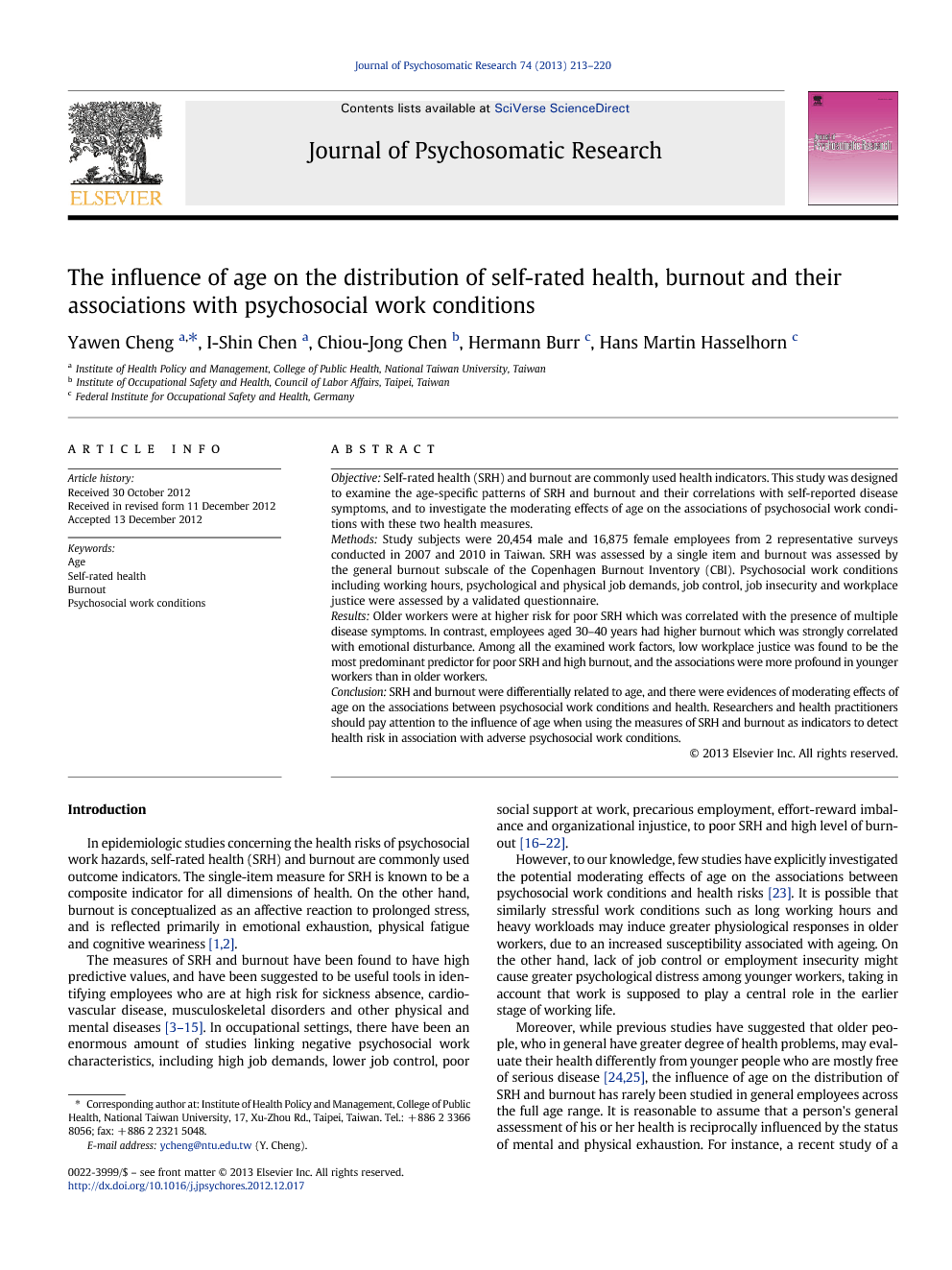Objective
Self-rated health (SRH) and burnout are commonly used health indicators. This study was designed to examine the age-specific patterns of SRH and burnout and their correlations with self-reported disease symptoms, and to investigate the moderating effects of age on the associations of psychosocial work conditions with these two health measures.
Methods
Study subjects were 20,454 male and 16,875 female employees from 2 representative surveys conducted in 2007 and 2010 in Taiwan. SRH was assessed by a single item and burnout was assessed by the general burnout subscale of the Copenhagen Burnout Inventory (CBI). Psychosocial work conditions including working hours, psychological and physical job demands, job control, job insecurity and workplace justice were assessed by a validated questionnaire.
Results
Older workers were at higher risk for poor SRH which was correlated with the presence of multiple disease symptoms. In contrast, employees aged 30–40 years had higher burnout which was strongly correlated with emotional disturbance. Among all the examined work factors, low workplace justice was found to be the most predominant predictor for poor SRH and high burnout, and the associations were more profound in younger workers than in older workers.
Conclusion
SRH and burnout were differentially related to age, and there were evidences of moderating effects of age on the associations between psychosocial work conditions and health. Researchers and health practitioners should pay attention to the influence of age when using the measures of SRH and burnout as indicators to detect health risk in association with adverse psychosocial work conditions.
In epidemiologic studies concerning the health risks of psychosocial work hazards, self-rated health (SRH) and burnout are commonly used outcome indicators. The single-item measure for SRH is known to be a composite indicator for all dimensions of health. On the other hand, burnout is conceptualized as an affective reaction to prolonged stress, and is reflected primarily in emotional exhaustion, physical fatigue and cognitive weariness [1] and [2].
The measures of SRH and burnout have been found to have high predictive values, and have been suggested to be useful tools in identifying employees who are at high risk for sickness absence, cardiovascular disease, musculoskeletal disorders and other physical and mental diseases [3], [4], [5], [6], [7], [8], [9], [10], [11], [12], [13], [14] and [15]. In occupational settings, there have been an enormous amount of studies linking negative psychosocial work characteristics, including high job demands, lower job control, poor social support at work, precarious employment, effort-reward imbalance and organizational injustice, to poor SRH and high level of burnout [16], [17], [18], [19], [20], [21] and [22].
However, to our knowledge, few studies have explicitly investigated the potential moderating effects of age on the associations between psychosocial work conditions and health risks [23]. It is possible that similarly stressful work conditions such as long working hours and heavy workloads may induce greater physiological responses in older workers, due to an increased susceptibility associated with ageing. On the other hand, lack of job control or employment insecurity might cause greater psychological distress among younger workers, taking in account that work is supposed to play a central role in the earlier stage of working life.
Moreover, while previous studies have suggested that older people, who in general have greater degree of health problems, may evaluate their health differently from younger people who are mostly free of serious disease [24] and [25], the influence of age on the distribution of SRH and burnout has rarely been studied in general employees across the full age range. It is reasonable to assume that a person's general assessment of his or her health is reciprocally influenced by the status of mental and physical exhaustion. For instance, a recent study of a sample of air force personnel indicated that perceived health was highly correlated with burnout—the latter was defined by the level of depletion of one's intrinsic energetic resources [26]. Nevertheless, information with regard to the correlations between self-rated health and burnout, as well as their correlations with the presence of disease symptoms—either physical or psychological—has been limited.
As illustrated in Fig. 1, this study was designed to examine the influence of age on the distribution of SRH and burnout, and to explore the moderating effects of age on the associations of psychosocial work conditions with SRH and burnout. Data from 2 rounds of national surveys encompassing employees of the full age range were utilized for this study.
Full-size image (21 K)
Fig. 1.
Influence of age on self-related health, burnout and their associations with psychosocial work conditions.
Figure options
Various instruments have been developed to measure burnout. Among all, the Maslach Burnout Inventory (MBI) has been the most widely used instrument. The MBI defines ‘burnout’ as a psychological consequence of prolonged stress arising out of work. According to the MBI, burnout is measured by a weighted sum of three components, namely ‘emotional exhaustion’, ‘depersonalization’ and ‘reduced personal accomplishment’ [1] and [27]. Similarly, the Oldenburg Burnout Inventory (OLBI) defines and assesses ‘burnout’ by the levels of ‘exhaustion’ and ‘disengagement’ [15] and [28]. By contrast, some measures, for instance, the Schirom Melamed Burnout Questionnaire and the personal burnout scale of the Copenhagen Burnout Inventory (CBI) [29] and [30], focus on the degree of general physical and psychological exhaustion experienced by the person regardless of its relation to work.
In this study, we focused on the core component of burnout, i.e., the overall physical and psychological exhaustion. We deliberately chose the personal burnout scale of the CBI which does not attribute burnout to work or other specific causes, because the association between work conditions and burnout was one of the study objectives to be examined.


